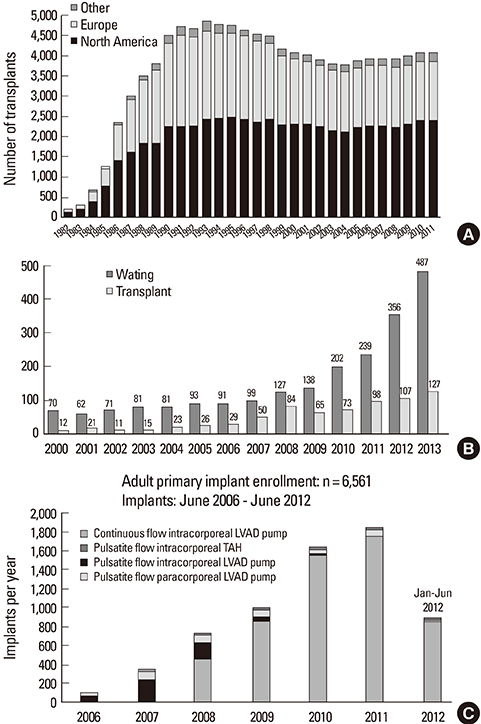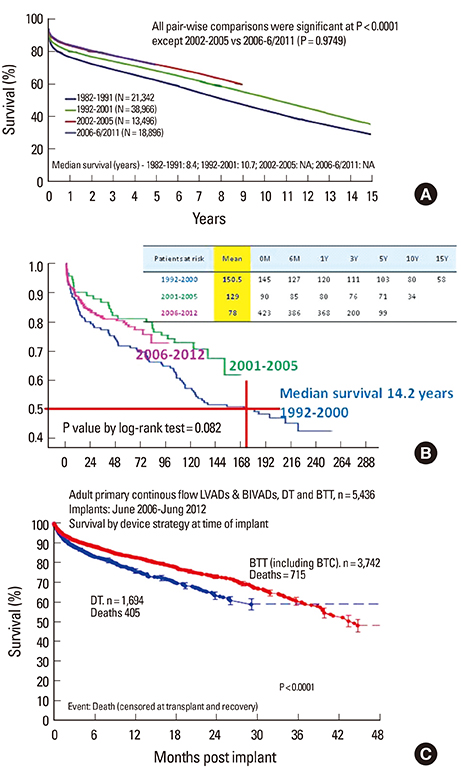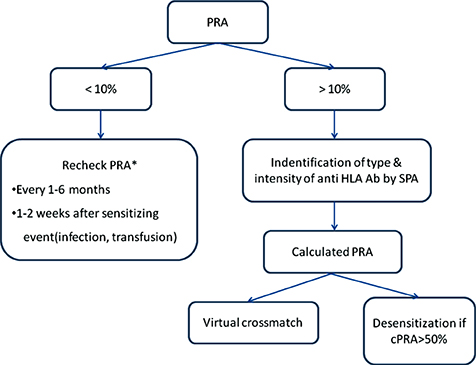Hanyang Med Rev.
2014 Nov;34(4):185-196. 10.7599/hmr.2014.34.4.185.
Current Status of Heart Transplantation and Left Ventricular Assist Device: Major Changes in the Last Decade
- Affiliations
-
- 1Division of Cardiology, Department of Internal Medicine, Sejong General Hospital, Bucheon, Korea. skjnlee@gmail.com
- 2Advanced Heart Failure and Transplantation Program, Columbia University Medical Center, New York-Presbyterian Hospital, New York, USA.
- KMID: 2168351
- DOI: http://doi.org/10.7599/hmr.2014.34.4.185
Abstract
- Heart transplantation is the last treatment option in refractory end stage heart failure, which can prolong survival. The number of heart transplantations has increased and the survival rate has improved during the last few decades which was contributed by advanced understanding of immunologic mechanism of rejection, pharmaceutical development and clinical management of donors and recipients. However, only a fraction of patients can be offered to transplantation due to shortage of donor heart and many patients suffer high mortality while waiting. Meanwhile, technical advancement of mechanical assist device in recent years enabled long term implantable left ventricular assist devices (LVAD) to bridge the patients with high mortality in the waiting list to transplantation and to assist as a long term destination therapy for patients who are not eligible for transplantation. Development of solid phase assay increased the sensitivity and the specificity of detection of anti-human leukocyte antigen (HLA) antibodies in the recipient. It enabled identifying unacceptable HLA antigens, acquire calculated Panel Reactive Antibodies and perform virtual cross match that can enhance the efficacy of donor allocation system to decrease the waiting time, obviate prospective cross match to decrease ischemic time and to assess the risk of rejection in presensitized patients. Antibody mediated rejection is a challenging entity in diagnosis and management. However, standardized classification of histology and immunology of endomyocardial biopsies was made recently and immunotherapy is moving toward targeted therapies directed at antibody production and function. This review focuses on those major changes in the heart transplantation field in the last decade.
MeSH Terms
Figure
Cited by 2 articles
-
Cutting Edge Technologies in Organ Transplantation
Dongho Choi
Hanyang Med Rev. 2014;34(4):143-144. doi: 10.7599/hmr.2014.34.4.143.Acute Myocardial Infarction due to Cardiac Allograft Vasculopathy: An Autopsy Report
Moon-Young Kim, Jang Han Kim, Min Jee Park, Soong Deok Lee
Korean J Leg Med. 2018;42(3):92-97. doi: 10.7580/kjlm.2018.42.3.92.
Reference
-
1. Lund LH, Edwards LB, Kucheryavaya AY, Dipchand AI, Benden C, Christie JD, et al. The Registry of the International Society for Heart and Lung Transplantation: Thirtieth Official Adult Heart Transplant Report--2013; focus theme: age. J Heart Lung Transplant. 2013; 32:951–964.
Article2. Kinkhabwala MP, Mancini D. Patient selection for cardiac transplant in 2012. Expert Rev Cardiovasc Ther. 2013; 11:179–191.
Article3. Colvin-Adams M, Valapour M, Hertz M, Heubner B, Paulson K, Dhungel V, et al. Lung and heart allocation in the United States. Am J Transplant. 2012; 12:3213–3234.
Article4. The Korean Liver Cancer Study Group. National Cancer Center. Practice guidelines for management of hepatocellular carcinoma [Internet]. Seoul (KR): Korean Medical Guideline Information Center;2014. cited 2014 Jun 1. Available from: http://www.guideline.or.kr/guideline/guide/contents.php?number=41&F_sid=908/.5. The Organ Procurement and Transplantation Network (OPTN) Annual Data Report [Internet]. Washington, DC (USA): U.S Department of health & human services;2014. cited 2014 Jul 1. Available from: http://srtr.transplant.hrsa.gov/annual_reports/2012/Default.aspx/.6. Jung SH, Kim JJ, Choo SJ, Yun TJ, Chung CH, Lee JW. Long-term mortality in adult orthotopic heart transplant recipients. J Korean Med Sci. 2011; 26:599–603.
Article7. Oh SI, Oh BH, Rho JR, Kim KB, Kim JJ, Song MG, et al. Results of heart transplantation in Korea. Korean J Med. 2001; 60:228–233.8. Lee GY, Choi J-O, Jeon ES. Current status of adult heart transplant in Korea: twenty-year experience. J Card Fail. 2014; 20:S103.
Article9. Rose EA, Gelijns AC, Moskowitz AJ, Heitjan DF, Stevenson LW, Dembitsky W, et al. Long-term use of a left ventricular assist device for end-stage heart failure. N Engl J Med. 2001; 345:1435–1443.
Article10. Slaughter MS, Rogers JG, Milano CA, Russell SD, Conte JV, Feldman D, et al. Advanced heart failure treated with continuous-flow left ventricular assist device. N Engl J Med. 2009; 361:2241–2251.
Article11. Miller LW, Pagani FD, Russell SD, John R, Boyle AJ, Aaronson KD, et al. Use of a continuous-flow device in patients awaiting heart transplantation. N Engl J Med. 2007; 357:885–896.
Article12. Aaronson KD, Slaughter MS, Miller LW, McGee EC, Cotts WG, Acker MA, et al. Use of an intrapericardial, continuous-flow, centrifugal pump in patients awaiting heart transplantation. Circulation. 2012; 125:3191–3200.
Article13. A Prospective, Randomized, Controlled, Un-blinded, Multi-Center Clinical Trial to Evaluate the HeartWare® Ventricular Assist System (VAS) for Destination Therapy of Advanced Heart Failure [Internet]. United States: A service of the U.S. National Institutes of Health;2014. cited 2014 Jul 17. Available from: http://clinicaltrials.gov/ct2/show/NCT01166347?term=NCT01166347&rank=1/.14. Kirklin JK, Naftel DC, Kormos RL, Stevenson LW, Pagani FD, Miller MA, et al. Fifth INTERMACS annual report: risk factor analysis from more than 6,000 mechanical circulatory support patients. J Heart Lung Transplant. 2013; 32:141–156.
Article15. Lietz K, Miller LW. Improved survival of patients with end-stage heart failure listed for heart transplantation: analysis of organ procurement and transplantation network/U.S. United Network of Organ Sharing data, 1990 to 2005. J Am Coll Cardiol. 2007; 50:1282–1290.
Article16. Patlolla V, Patten RD, Denofrio D, Konstam MA, Krishnamani R. The effect of ventricular assist devices on post-transplant mortality an analysis of the United network for organ sharing thoracic registry. J Am Coll Cardiol. 2009; 53:264–271.17. Healy AH, Baird BC, Drakos SG, Stehlik J, Selzman CH. Impact of ventricular assist device complications on posttransplant survival: an analysis of the United network of organ sharing database. Ann Thorac Surg. 2013; 95:870–875.
Article18. John R, Pagani FD, Naka Y, Boyle A, Conte JV, Russell SD, et al. Post-cardiac transplant survival after support with a continuous-flow left ventricular assist device: impact of duration of left ventricular assist device support and other variables. J Thorac Cardiovasc Surg. 2010; 140:174–181.
Article19. Miller LW, Guglin M. Patient selection for ventricular assist devices: a moving target. J Am Coll Cardiol. 2013; 61:1209–1221.20. Starling RC, Naka Y, Boyle AJ, Gonzalez-Stawinski G, John R, Jorde U, et al. Results of the post-U.S. Food and Drug Administration-approval study with a continuous flow left ventricular assist device as a bridge to heart transplantation: a prospective study using the INTERMACS (Interagency Registry for Mechanically Assisted Circulatory Support). J Am Coll Cardiol. 2011; 57:1890–1898.
Article21. Timms D. A review of clinical ventricular assist devices. Med Eng Phys. 2011; 33:1041–1047.
Article22. Park SJ, Milano CA, Tatooles AJ, Rogers JG, Adamson RM, Steidley DE, et al. Outcomes in advanced heart failure patients with left ventricular assist devices for destination therapy. Circ Heart Fail. 2012; 5:241–248.
Article23. Boyle AJ, Ascheim DD, Russo MJ, Kormos RL, John R, Naka Y, et al. Clinical outcomes for continuous-flow left ventricular assist device patients stratified by pre-operative INTERMACS classification. J Heart Lung Transplant. 2011; 30:402–407.
Article24. Starling RC, Moazami N, Silvestry SC, Ewald G, Rogers JG, Milano CA, et al. Unexpected abrupt increase in left ventricular assist device thrombosis. N Engl J Med. 2014; 370:33–40.
Article25. Kobashigawa JA, Sabad A, Drinkwater D, Cogert GA, Moriguchi JD, Kawata N, et al. Pretransplant panel reactive-antibody screens. Are they truly a marker for poor outcome after cardiac transplantation? Circulation. 1996; 94:Ii294–Ii297.26. Stehlik J, Edwards LB, Kucheryavaya AY, Aurora P, Christie JD, Kirk R, et al. The Registry of the International Society for Heart and Lung Transplantation: twenty-seventh official adult heart transplant report--2010. J Heart Lung Transplant. 2010; 29:1089–1103.
Article27. Patel R, Terasaki PI. Significance of the positive crossmatch test in kidney transplantation. N Engl J Med. 1969; 280:735–739.
Article28. Cecka JM. Calculated PRA (CPRA): the new measure of sensitization for transplant candidates. Am J Transplant. 2010; 10:26–29.
Article29. Stehlik J, Islam N, Hurst D, Kfoury AG, Movsesian MA, Fuller A, et al. Utility of virtual crossmatch in sensitized patients awaiting heart transplantation. J Heart Lung Transplant. 2009; 28:1129–1134.
Article30. Schaffer JM, Singh SK, Reitz BA, Oyer PE, Robbins RC, Mallidi HR. Heart transplant graft survival is improved after a reduction in panel reactive antibody activity. J Thorac Cardiovasc Surg. 2013; 145:555–564. discussion 64-5.
Article31. Kobashigawa JA, Patel JK, Kittleson MM, Kawano MA, Kiyosaki KK, Davis SN, et al. The long-term outcome of treated sensitized patients who undergo heart transplantation. Clin Transplant. 2011; 25:E61–E67.
Article32. Schumacher KR, Ramon DS, Kamoun M, Caruthers R, Gajarski RJ. HLA desensitization in pediatric heart transplant candidates: efficacy of rituximab and IVIg. J Heart Lung Transplant. 2012; 31:1041–1042.
Article33. Vo AA, Lukovsky M, Toyoda M, Wang J, Reinsmoen NL, Lai CH, et al. Rituximab and intravenous immune globulin for desensitization during renal transplantation. N Engl J Med. 2008; 359:242–251.
Article34. Patel JK, Everly MJ, Kittleson M, Kobashigawa JA. Use of bortezomib as adjunctive therapy for densensitization in combined heart and kidney transplantation--a case report. Clin Transpl. 2009; 347–349.35. Perry DK, Burns JM, Pollinger HS, Amiot BP, Gloor JM, Gores GJ, et al. Proteasome inhibition causes apoptosis of normal human plasma cells preventing alloantibody production. Am J Transplant. 2009; 9:201–209.
Article36. Beniaminovitz A, Itescu S, Lietz K, Donovan M, Burke EM, Groff BD, et al. Prevention of rejection in cardiac transplantation by blockade of the interleukin-2 receptor with a monoclonal antibody. N Engl J Med. 2000; 342:613–619.
Article37. Mehra MR, Zucker MJ, Wagoner L, Michler R, Boehmer J, Kovarik J, et al. A multicenter, prospective, randomized, double-blind trial of basiliximab in heart transplantation. J Heart Lung Transplant. 2005; 24:1297–1304.
Article38. Deng MC, Eisen HJ, Mehra MR, Billingham M, Marboe CC, Berry G, et al. Noninvasive discrimination of rejection in cardiac allograft recipients using gene expression profiling. Am J Transplant. 2006; 6:150–160.
Article39. Pham MX, Teuteberg JJ, Kfoury AG, Starling RC, Deng MC, Cappola TP, et al. Gene-expression profiling for rejection surveillance after cardiac transplantation. N Engl J Med. 2010; 362:1890–1900.
Article40. Costanzo MR, Dipchand A, Starling R, Anderson A, Chan M, Desai S, et al. The International Society of Heart and Lung Transplantation Guidelines for the care of heart transplant recipients. J Heart Lung Transplant. 2010; 29:914–956.
Article41. Grimm M, Rinaldi M, Yonan NA, Arpesella G, Arizon Del, Pulpon LA, et al. Superior prevention of acute rejection by tacrolimus vs. cyclosporine in heart transplant recipients--a large European trial. Am J Transplant. 2006; 6:1387–1397.
Article42. Taylor DO, Barr ML, Radovancevic B, Renlund DG, Mentzer RM Jr, Smart FW, et al. A randomized, multicenter comparison of tacrolimus and cyclosporine immunosuppressive regimens in cardiac transplantation: decreased hyperlipidemia and hypertension with tacrolimus. J Heart Lung Transplant. 1999; 18:336–345.
Article43. Eisen HJ, Tuzcu EM, Dorent R, Kobashigawa J, Mancini D, Valantine-von Kaeppler HA, et al. Everolimus for the prevention of allograft rejection and vasculopathy in cardiac-transplant recipients. N Engl J Med. 2003; 349:847–858.
Article44. Kaczmarek I, Ertl B, Schmauss D, Sadoni S, Knez A, Daebritz S, et al. Preventing cardiac allograft vasculopathy: long-term beneficial effects of mycophenolatemofetil. J Heart Lung Transplant. 2006; 25:550–556.
Article45. Vigano M, Tuzcu M, Benza R, Boissonnat P, Haverich A, Hill J, et al. Prevention of acute rejection and allograft vasculopathy by everolimus in cardiac transplants recipients: a 24-month analysis. J Heart Lung Transplant. 2007; 26:584–592.
Article46. Eisen HJ, Kobashigawa J, Starling RC, Pauly DF, Kfoury A, Ross H, et al. Everolimus versus mycophenolatemofetil in heart transplantation: a randomized, multicenter trial. Am J Transplant. 2013; 13:1203–1216.
Article47. Kobashigawa JA, Miller LW, Russell SD, Ewald GA, Zucker MJ, Goldberg LR, et al. Tacrolimus with mycophenolatemofetil (MMF) or sirolimus vs. cyclosporine with MMF in cardiac transplant patients: 1-year report. Am J Transplant. 2006; 6:1377–1386.
Article48. Potena L, Prestinenzi P, Bianchi IG, Masetti M, Romani P, Magnani G, et al. Cyclosporine lowering with everolimus versus mycophenolatemofetil in heart transplant recipients: long-term follow-up of the SHIRAKISS randomized, prospective study. J Heart Lung Transplant. 2012; 31:565–570.
Article49. Patel JK, Kittleson M, Kobashigawa JA. Cardiac allograft rejection. Surgeon. 2011; 9:160–167.
Article50. Berry GJ, Angelini A, Burke MM, Bruneval P, Fishbein MC, Hammond E, et al. The ISHLT working formulation for pathologic diagnosis of antibody-mediated rejection in heart transplantation: evolution and current status (2005-2011). J Heart Lung Transplant. 2011; 30:601–611.
Article51. Kittleson MM, Kobashigawa JA. Antibody-mediated rejection. Curr Opin Organ Transplant. 2012; 17:551–557.
Article
- Full Text Links
- Actions
-
Cited
- CITED
-
- Close
- Share
- Similar articles
-
- The First Pediatric Heart Transplantation Bridged by a Durable Left Ventricular Assist Device in Korea
- Temporary Right Ventricular Assist Device Insertion via Left Thoracotomy after Left Ventricular Assist Device Implantation
- The anesthetic experience of implantable left ventricular assist device insertion: a case report
- Optimal timing of heart transplantation in patients with an implantable left ventricular assist device
- Exercise Therapy for an Older Patient With Left Ventricular Assist Device




